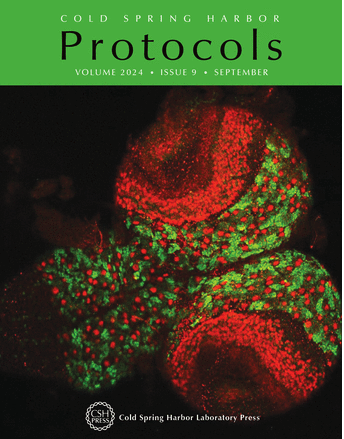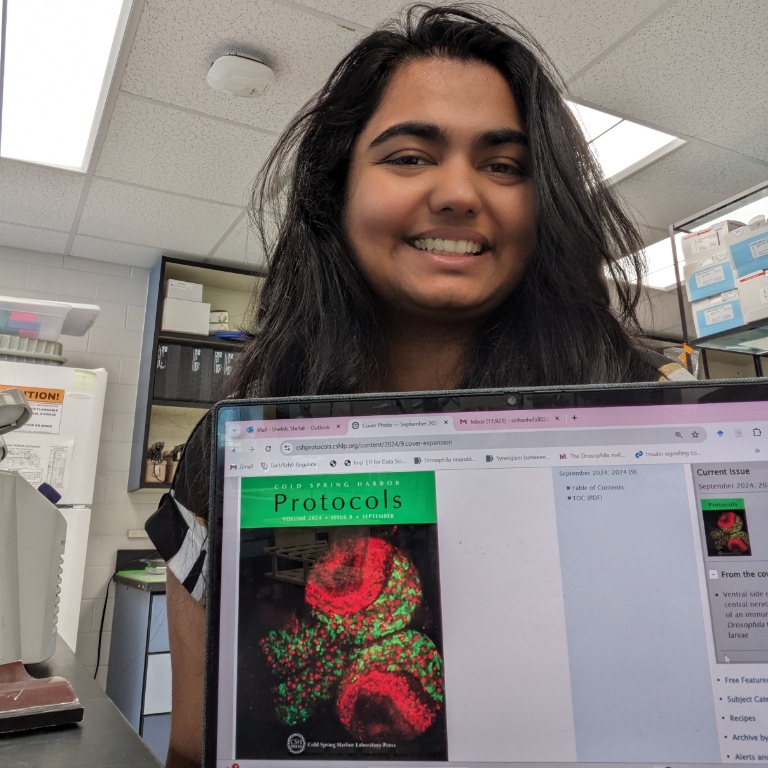Indiana University Bloomington graduate student Shefali Shefali was honored by having her work selected for the cover of the September issue of Cold Spring Harbor Protocols. Shefali is a Ph.D. candidate in the Genome, Cell, and Developmental Biology (GCDB) program in the Department of Biology, conducting research in the Tennessen lab.
Cold Spring Harbor Protocols is an interdisciplinary journal that provides a definitive source of research methods in cell, developmental and molecular biology, genetics, bioinformatics, protein science, computational biology, immunology, neuroscience and imaging.
In this Q&A, Shefali discusses her research, the cover image and more.
Q: How would you caption the image on the cover?
I always call it “The Colorful Brain.”
 Q: What’s the research behind it?
Q: What’s the research behind it?
The Tennessen lab is broadly interested in determining how an animal coordinates its metabolic needs according to its developmental stage-specific requirements using the fruit fly Drosophila melanogaster as our model system. My thesis is devoted to identifying signaling pathways that coordinate metabolism and development across multiple organ systems. I am focused on studying how glucose metabolism coordinates the brain-body growth signaling axis, and how its aberration can impact cellular dynamics of the brain. The brain-body axis is a powerful system to study inter-organ metabolic signaling because not only is it conserved in many metazoans, but also has clear implications in diseases like diabetes, neurodegeneration and cancer.
The image shows the central nervous system (CNS) from third-instar Drosophila larvae (juvenile brain), highlighting the neural stem cells in red and ganglion mother cells in green. The Drosophila larval brain has a unique structure of having two optic lobes and a ventral nerve cord - and in this image one can appreciate the heterogeneous cellular morphology of the central brain and optic lobes. Many studies have shown that systemic metabolism can have chronic impacts on brain development, but my study would be showing a novel mechanism by which glucose dependent signals can non-autonomously regulate cellular homeostasis within the brain. My work will be important to understand how expression patterns of metabolic enzymes, which are often thought of as housekeeping enzymes not only maintain systemic energy homeostasis, but also significantly impact cell fate decisions to have wide-range health implications.
My work has been appreciated in my field, and I was recently selected to present a platform talk in the “Disease Models and Aging" session at The Allied Genetics Conference (TAGC), 2024. Moreover, my work has also been recognized at IU and I have been awarded with 2023-24 IUCOAS Kindig fellowship, 2024 Briggs fellowship and 2024 Dona Graam fellowship to support my graduate training.
Q: How was it selected, and what was your reaction?
The CSHL press executive editor, Dr. Alejandro Montenegro-Montero had made an announcement for a call for Drosophila brain images, and I sent mine. I was ecstatic and beyond thrilled to find out that my image had been chosen.
Q: Is there anything else you’d like to add?
I serve as the elected graduate student representative at the flyboard, an international Drosophila advisory board, that oversees the international Drosophila community. In this role, I organized a “Behind the Science Stories” workshop at The Allied Genome Research Conference 2024, which featured some of the most incredible scientists in the country. The workshop was very well received by both early career faculty members and trainees – as they learned what goes into running a lab, finishing a story and fighting unseen battles. Additionally, I am working on establishing a mentor-mentee program for the early career scientists in the fly community.

 The College of Arts
The College of Arts